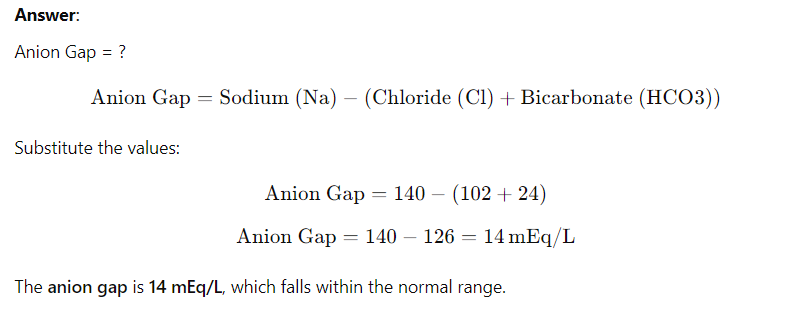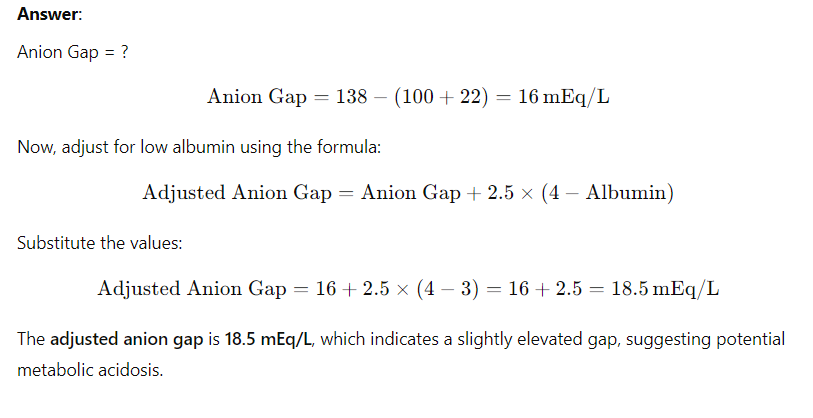Anion Gap Calculator for Acid-Base Disorders
This Anion Gap Calculator helps healthcare professionals quickly assess acid-base disorders, particularly metabolic acidosis, by calculating the difference between measured cations and anions in the blood. Using the patient’s Sodium (Na), Chloride (Cl), and Bicarbonate (HCO3) levels, it provides an accurate anion gap calculation.
Anion Gap
The Anion Gap is a crucial calculation used to assess acid-base imbalances in the body, particularly metabolic acidosis. This measurement is based on the concentrations of key electrolytes—Sodium (Na), Chloride (Cl), and Bicarbonate (HCO3)—in the blood.
In clinical settings, the Anion Gap helps determine whether the cause of metabolic acidosis is due to the accumulation of acids (e.g., diabetic ketoacidosis, renal failure) or a loss of bicarbonate. The normal anion gap range is typically between 8 to 16 mEq/L, depending on lab reference ranges.
If Albumin levels are low (hypoalbuminemia), an Adjusted Anion Gap can be calculated to account for this, providing a more accurate reflection of the patient’s acid-base status.
Anion Gap Formula
The Anion Gap Formula is calculated by subtracting the sum of Chloride (Cl) and Bicarbonate (HCO3) from the Sodium (Na) level in mEq/L:

In cases where Albumin levels are low, the Adjusted Anion Gap is calculated by adding 2.5 mEq/L for every 1 g/dL decrease in albumin below the normal value of 4 g/dL:

With the Anion Gap Calculator, you can quickly and accurately assess acid-base disorders, helping healthcare professionals make informed treatment decisions.
Calculation Example 1
Learn how to use the Anion Gap Calculator to assess metabolic acidosis.
Example 1:
If a patient has the following electrolyte values:
- Sodium (Na): 140 mEq/L
- Chloride (Cl): 102 mEq/L
- Bicarbonate (HCO3): 24 mEq/L
Calculate the anion gap.

Calculation Example 2
Now, let’s calculate the adjusted anion gap for a patient with low albumin levels.
Example 2:
If a patient has:
- Sodium (Na): 138 mEq/L
- Chloride (Cl): 100 mEq/L
- Bicarbonate (HCO3): 22 mEq/L
- Albumin: 3 g/dL (below the normal 4 g/dL)
Calculate the adjusted anion gap.

General Tips
Ensure Clinical Relevance: Double-check that the calculated anion gap makes clinical sense in the context of the patient’s symptoms and overall clinical picture.
Double-Check Your Work: Always verify your calculation to avoid potential misinterpretations. Errors can affect treatment decisions.
Seek Verification: If you’re unsure about the result, consult a colleague or a pharmacist to verify the calculation and ensure its accuracy.
Understand Electrolyte Norms: Know the normal ranges for electrolytes and how deviations can affect the anion gap. This will help you better interpret abnormal values.
How to Use the Anion Gap Calculator
Input Electrolyte Values:
- Enter the patient’s Sodium (Na) level in mEq/L.
- Enter the patient’s Chloride (Cl) level in mEq/L.
- Enter the patient’s Bicarbonate (HCO3) level in mEq/L.
Calculate the Anion Gap:
- Click the “Calculate” button, and the Anion Gap will be displayed based on the entered values.
Optional: Enter Albumin for Adjusted Anion Gap:
- If the patient has low albumin levels (hypoalbuminemia), enter the Albumin (g/dL) to adjust the anion gap for more accurate clinical assessment.
View Results:
- After calculating, the Anion Gap or Adjusted Anion Gap will be displayed in mEq/L. Use the values to assess the patient’s acid-base balance and guide clinical decisions.
Additional Measurement Tools
If you’re interested in related calculators for electrolyte and metabolic measurements, you may also want to check out:
- Acid-Base Analysis Tools: Analyze the patient’s full acid-base status for more comprehensive diagnostic insights.
- Electrolyte Correction Calculators: Quickly determine the necessary electrolyte adjustments for clinical management.
FAQs
What is the Anion Gap?
The Anion Gap is a calculation used to measure the difference between positively charged ions (cations) and negatively charged ions (anions) in a patient’s blood. It is primarily used to assess acid-base disorders, especially metabolic acidosis, and can help identify underlying conditions such as diabetic ketoacidosis, renal failure, or lactic acidosis.
What is the Anion Gap Formula?
The formula to calculate the Anion Gap is:
This formula calculates the balance between measured cations (positively charged ions) and anions (negatively charged ions). A normal anion gap is typically between 8 to 16 mEq/L depending on the lab’s reference range.
What is the Adjusted Anion Gap?
The Adjusted Anion Gap accounts for low levels of Albumin in the blood (hypoalbuminemia). Since albumin is a major negatively charged protein, its low levels can affect the accuracy of the standard anion gap calculation. The adjusted formula is:

This adjustment corrects the gap by accounting for the difference in albumin levels from the normal value of 4 g/dL.
These updates help provide concise, easy-to-understand answers to the most common questions regarding the Anion Gap Calculator while explaining both the standard and adjusted formulas.